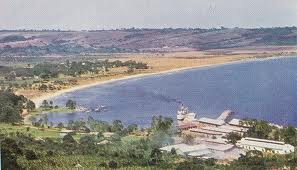

Please replace.."I am here" with "L&S are there" :-)

As planned Hairy Larry & Sharon went to Hairy Lemon! An island in the middle of the White Nile (info below).
Sharon's chest/ribs still hurt and bruises are slowly getting better. I must admit that I wondered if those fancy, blue BMW "space suits" (protective riding gear) were really worth the money or was it one of those "name brand" foefies? Well it turned out that The Space Suit (respectfully in capital letters :-))protected Sharon from serious injuries, especially to her knee!
They hope to pick up the bike tomorrow and taking it easy to Kenya.
THE HAIRY LEMON
The Irish owners of this Ugandan retreat along the Nile River outside of Kampala named the place after a favorite pub in Dublin.An island archipelago on the magnificent Nile, the Hairy Lemon Island provides secluded bandas, family cottages, dormitories, and camping areas tucked under canopies of rain forest. The Nile flows in shallow eddies, between the islands, creating natural pools for swimming, volleyball and is also a sort after spot for sports fishermen and bird watchers from all over the world.
NILE
The Nile is the longest river in the world, flowing 6695km (4184 miles). There are two main rivers which flow from the south into what is referred to as the Nile Proper, the Blue Nile, and the White Nile. The White Nile is the longer of the tributaries, but the Blue Nile is the main source of water and fertile soil. A third river, the Atbara, flows into the Nile just north of Khartoum in the Sudan but it contributes less than one percent to total water flow.
The White Nile is so named because of the light coloured clay sediment suspended in the water giving the river a light gray colour.
The White Nile contributes about sixteen percent of the total water flow in the Nile. This doesn't sound like much, however the White Nile as a more steady flow of water which keeps the Nile proper from running dry in April and May, supplying about eighty percent of the Nile's water during these months.
The origins of the White Nile are in deep central Africa, as far south as southern Rwanda. The river flows north through Tanzania, Lake Victoria, Uganda and into Southern Sudan.
The falls at Lake Tana, Ethiopia are the source of the Blue Nile.
The Blue Nile flows about 1,400 km (850 miles) to Khartoum from Lake Tana 1,800 meters above sea level in the Ethiopian Mountains. Lake Tana floods every summer from June to September, feeding the Blue Nile. This flood is extremely important because it is only during this time that erosion and transportation of the fertile silt occurs. This fertile soil is what gave life to the Nile Valley.
The White and Blue Nile Rivers merge near the Sudanese capital of Khartoum, becoming the Nile proper which itself flows in two distinct parts. An 1336 km (830 mile) long stretch of the Nile flows through the desert allowing irrigation and agriculture in these areas. Along this stretch, the river passes through a series of cataracts causing the gentile river to change to violent rapids making some areas unnavigable. The rocks are composed of hard igneous rock forming a natural boundary between what was known as Upper and Lower Nubia.
The second part is from Lake Nasser, the world's second largest man-made lake. Lake Nasser is where the Nile's waters are held back by the Aswan High Dam constructed in 1970: at which time the Nile's annual floods which had occurred for thousands of years, ceased.
The Nile continues northward from the dam for about 805 km (500 miles) to Cairo and on northward to form the Nile Delta composed of silt fifty to seventy-five feet deep from the Ethiopian plateau. The Nile mud is perhaps the most fertile soil on the planet. It is composed of about 0.1 percent Nitrogen, 0.2 percent phosphorus anhydrides and 0.6 percent potassium.
The Delta spans some 22015 sq. km (8,500 sq. miles) and is fringed in its coastal regions by lagoons, wetlands, lakes and sand dunes.
Throughout the delta there are high points of mounds of clay and silt rising high enough to escape flooding. Egyptologists have found evidence of very early settlements in these areas. Interestingly, there is an ancient Egyptian creation myth of the world having begun on a mound of earth which emerged from the waters.
The annual flooding of the Nile had taken place for thousands of years. Waters of the Blue Nile would begin to rise when the heavy rainfall season began in Ethiopia. The floodwaters would reach the Sudan by May.
In July, the floods reach the Aswan High Dam in Egypt. The Nile's water continues to increase. By August, averages are over twenty feet at Khartoum. The Nile peaks about mid September.
Lake Nasser was created with the construction of the Aswan Dam from spillover. This increases especially during flood times because then, the Blue Nile hold the White Nile back.
The Nile's levels rose throughout the 1990's causing additional spilling over of water eastward into the Sahara Desert and by 1998 had formed the Toshka Lakes.
The ancient Egyptians called the Nile “Aur” or “Kem” which meant black, after the fertile black soil brought to them by the river and it was around the Nile that their lives focused. Even the ancient Egyptian calendar was based on the Nile, composed of twelve months of thirty days each. Their year was divided into three seasons, each based on cycles of the river.
















































